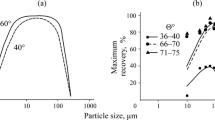Abstract
Methods for evaluation of the adsorption and orientation of heteropolar molecules of reagents in the adsorption layer on the surface of particles and the adsorption of reagents on the surface of bubbles are considered. Experiments of nonfrothing flotation from a turbulent medium, methods of froth flotation (FF) with a limited air consumption, measurement of detachment forces simulating the FF, determination of the adherence times of the particles to the bubbles, and measurement of the contact angles can be used to reveal the character of the orientation of adsorbed molecules or ions of reagents. To evaluate the adsorption of reagents on the surface of bubbles, only static procedures for determination of the surface tension (σ), methods of recording the relaxation curves σ(t), and methods for evaluation of froth formation and destruction can be used. This possibility is reviewed to establish the relation between the definite properties of reagents and their concrete effect under the dynamic FF.
Similar content being viewed by others
References
Bogdanov, O.S., Gol’man, A.M., Kakovskii, I.A., et al., Fiziko-khimicheskie osnovy teorii flotatsii (Physicochemical Foundations of the Flotation Theory), Moscow: Nauka, 1983.
Melik-Gaikazyan, V.I., Abramov, A.A., Rubintshtein, Yu.B., et al., Metody issledovaniya flotatsionnogo protsessa (Methods of Investigation of the Flotation Process), Moscow: Nedra, 1990.
Melik-Gaikazyan, V.I., Emel’yanova, N.P., Kozlov, P.S., et al., Izv. Vyssh. Uchebn. Zaved., Tsvetn. Metall., 2009, no. 2, p. 7.
Melik-Gaikazyan, V.I. and Emel’yanova, N.P., Izv. Vyssh. Uchebn. Zaved., Tsvetn. Metall., 2007, no. 4, p. 4.
Melik-Gaikazyan, V.I., Emel’yanova, N.P., Kozlov, P.S., et al., Izv. Vyssh. Uchebn. Zaved., Tsvetn. Metall., 2008, no. 2, p. 6.
Taggart, A.F. and Gaudin, A.M., Trans. AIME, 1923, vol. 68, p. 479.
Taggart, A.F., Spravochnik po obogashcheniyu poleznykh iskopaemykh, (Handbook of Mineral Dressing), Moscow: GNTI, 1933, vol. 2; New York: Wiley, 1945.
Hoover, Th.J., Concentrating Ores by Flotation, 3rd Edition, London: Mining Magazine, 1916.
Mitrofanov, S.I., Issledovanie rud na obogatimost’ (Investigation of Ores for Washability), Moscow: GNTI, 1954.
Melik-Gaikazyan, V.I., Draganov, A.V., Eml’yanova, N.P., et al., Gorn. Inf.-Analit. Byul. MGGU, 2006, no. 1, p. 349.
Melik-Gaikazyan, V.I., Emel’yanova, N.P., Kozlov, P.S., et al., Gorn. Inf.-Analit. Byul. MGGU, 2007, no. 9, p. 316.
Author information
Authors and Affiliations
Corresponding author
Additional information
Original Russian Text © V.I. Melik-Gaikazyan, N.P. Emel’yanova, P.S. Kozlov, 2010, published in Izvestiya VUZ. Tsvetnaya Metallurgiya, 2010, No. 2, pp. 7–11.
The first part of this work was published in Izv. Vuz. Tsvetn. Met., 2010, no. 1, p. 7 [Russ. J. Nonfer. Met. (Engl. Transl.), 2010, no. 6].
About this article
Cite this article
Melik-Gaikazyan, V.I., Emel’yanova, N.P. & Kozlov, P.S. Development of investigation techniques of froth flotation from the beginning of its wide industrial use. Part two. Methods of evaluation of the adsorption and orientation of heteropolar molecules of reagents in the adsorption layer on the surface of particles. Russ. J. Non-ferrous Metals 51, 89–93 (2010). https://doi.org/10.3103/S1067821210020021
Published:
Issue Date:
DOI: https://doi.org/10.3103/S1067821210020021




